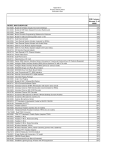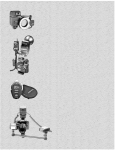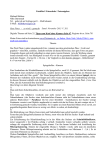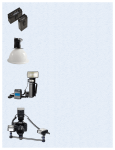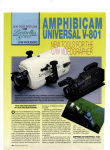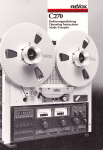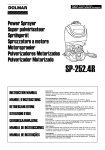Download Minolta MAXXUM FLASH 5600HSD - PART 2 Instruction manual
Transcript
cameraJequipmentY accessories T buyer's guide ron. 'ortable light, wheneveTand wherever you need it Photos and text by Jack and Sue Drafahl E lectronic flash is such an important part of photography today that most consumer cameras, both traditional and digital, have a built-in electronic flash. When these little units can't do an adequate job, then a separate portable flash unit is a valuable accessory. There are dozens of advantages to using an electronic flash, besides its creative options. Flash allows you to use slower films, since you don't have to depend on ambient light for exposure. Your images are sharper because the duration of most flash units is Xooo second or shorter. Electronic flash is balanced to sunlight, so it works well with daylight-balanced color films. Because the burst of light is brief, strobes allow you to capture the fast action of moving subjects. You can bounce the flash to provide a natural soft lighting for portraits. Flash is ideal for extreme macro work because at such close range, it allows shooting at small apertures for optimum depth of field. Electronic flash provides the tools to enhance your photography by controlling the light, both indoors and out. Dedicated Flash Units Unlike automatic flash units that are controlled by the light-sensitive cell on the front of the flash, dedicated flash units operate via sensors inside the camera. These dedicated flashes have very complex electronics featuring dozens of functions, enabling the flash to do just about anything you want it to do. They control the exposure, so you don't have to do much more than turn the flash unit on and begin shooting. When you place a flash on the hot-shoe of a newer 35mm camera, the flash and camera communicate with each other. The camera tells the flash the speed of the film and the focal length of the lens you are using, and sets the shutter speed for proper sync. The camera then selects the appropriate aperture to provide a correct exposure based on the amount of light available. All this team effort happens in just a micro second to make your pictures look good. Flash units manufactured for a specific camera system are considered dedicated because each camera system has a different electronic system for operating the shutter, 56 2002 PHorographic Buyer's Guide measuring light, and firing the flash. This complex set of signals must be the same for both the camera and flash to work effectively. There are third-party flash manufacturers that also make flash units dedicated to a specific camera. The difference is that they must also have a module that fits between the flash and the camera hot-shoe. Thanks to good camera and flash communication, your work is easier. The flash adjusts itself automatically when the flash-to-subject distance is changed so you don't have to spend time adjusting the aperture. If you change to a new lens focal length, the flash will know and automatically adjust the angle of coverage in the zoom head. Flash-fill situations are a piece of cake too, as the camera and flash know how much sunlight is available in the scene, and just how much flash to add to achieve the right fill combination. You can also manually override the flash ratio using the +1controls. If you stop taking pictures to talk to someone, the flash will go into a standby mode until you are ready to shoot again. Most of the flash units will even tell you with blinking lights when you have taken a picture that is overor underexposed. Guide Numbers Guide numbers provide two handy functions. First, they give you an easy way to compare the power of two or more flash units (just make sure all guide numbers being compared are for the same film speed and the same angle of coverage). The guide number also provides an easy method of determining the proper f-stop to use for a manually exposed flash photo: Just divide the flash-tosubject distance into the guide number, and the result is the f-stop to use. For example, let's say that your flash has a guide number of 110 for the film speed you're using. If you are 10 feet away, you divide the distance into the guide number, and you get f/11. If you are uncomfortable with guide numbers or don't know what it is for your flash (it should be in the instruction manual, or on the manufacturer's website), not to worry. You can also use the bar chart or the LCD panel on the back of the flash to compute your exposure. Flash Features moving your model further away from the wall or by raising Manual Flash: With the flash setting in this position, the flash unit so that the shadow is cast down behind your you can select full power, half power, quarter power or less. subject. The other solution is to have a flash that allows you to Settings on the back of the flash tell you what f-stop to use move the head to various positions. Many flash heads can with a particular ISO film speed at different distances to the twist, rotate, and flip. This movable flash head allows you to subject. point the flash in various directions, to achieve directional Fast Recycle Time: When the electronic flash first came lighting. Best of all, you can "bounce" the light off a ceiling out, the operation was simple. You turned the flash on, and or wall to achieve a softer portrait lighting. When bouncing when the shutter opened, the flash would dump all of its the light, remember flash power in one that it is important large burst of light. to use a white or The system would off-colored surface. recharge and be Otherwise, the ready for the next hu reflected surface's shot. Most color will be electronic flash transmitted to your units today have subject and give it special electronic a strange hue. circuitry that can You can also fire a partial burst find flash heads of light when full that have a zoom power isn't needed, feature. The zoom and save the function allows you remaining power to match the beam for the next shot. angle of the flash to This gives you the camera lens. accurate control You can spread the over your exposures light for a widebecause the flash angle photo or cutoff can be in narrow the beam small increments of for telephoto. With power output. The dedicated flash fact that not all the units, the focal power is zapped length of the means the flash can camera lens is quickly build back transmitted to the up to full power so zoom head and it the recycle time is sets the correct shortened. Fast beam angle flash recycle time is automatically. the key to not Diffusors can help missing that allexpand the beam important photo. angle even more for Flash superwide-angle Duration: The lenses, or reduce it duration of an Flash can add light wherever it is needed. Here, it was used to fill the too-dark foreground subject. for longer telephoto electronic flash lenses. Some of the newer flash units even have built-in unit decreases at low power settings (in manual mode) and white bounce cards to soften the light. close shooting distances (in auto mode). This flash duration Red-Eye Reduction: A common problem when taking can be as little as Xo.ooo second, which results in very sharp portraits with compact cameras and on-camera flash units is pictures of action subjects. This feature is especially useful called red-eye. The human eye opens its aperture just like a for macro photographers, where slight movement is camera lens to adjust for low levels of light. When the flash exaggerated when you get down to a 1:1 ratio and beyond. fires, it strikes the back of the eye through the large Flash Heads: Portraits taken with a built-in flash or one attached directly on top of the camera seem to be what most opening, and reflects back as a red-eye. The red-eye reduction feature available on many flash units today is a people produce. That's a shame, because it produces harsh pre-flash that sends out short bursts of flashes before the shadows on walls behind your subject, little feeling of depth shutter opens. The subject's pupils automatically close down, and often causes red-eye. You can eliminate the shadow by 2002 PHOTOgraphic Buyer's Guide 57 and the effect of red-eye is minimized in the final photo. (This feature is called red-eye reduction, not red-eye elimination—the only way to eliminate red-eye is to move the flash unit off-camera. More on that in a bit.) Slow Sync: Most automatic cameras will not let you make long available-light exposures using flash. They normally set a flash sync speed that enables you to handhold the camera. This results in a dark background, but with the nearby subject correctly exposed by the flash. If you use slow sync, you can set the camera at a very slow shutter speed and the camera will automatically balance the low light exposure with the flash. You may have to use a tripod to avoid camera movement and have the subjects limit their movement for the exposure. On the other hand, you may be creative and have the subjects move throughout the exposure, resulting in burred movement. Rear-Curtain Sync: Normally, the flash fires at the beginning of the exposure. This flash exposure lights the subject, resulting in a sharp image, and then a blurred image is recorded from the ambient light. The blur shows up after the sharp image was recorded, but is positioned in front of the subject in the photo. With rear-curtain sync, the flash fires at the end of the exposure, resulting in blurred movement behind a moving object. This effect is mainly used to give a feeling of motion to the image. Slave Flash: You can also use several flash units to light a scene, by attaching a small electronic device called a slave to the auxiliary flashes. The slaves will trigger the units to which they are attached when the flash on-camera fires. Some flash units have this slave function built-in, so all you 58 2002 PnoTOgraphic Buyer's Guide have to do is turn a switch. The output from the slave unit varies, depending on the sophistication of the flash. Some units can only dump full power, while others feature variable power settings. Often the slave unit mimics the main flash and shuts off its output when the main flash does. Most dedicated slave units feature full TTL capability via optical or radio cordless transmission. AF-Assist Light: The AF-assist light is a special light grid that is projected out to the subject when there is not enough light for the camera to accurately focus. The camera is then able to focus quickly on the grid as it falls on the subject. This grid light is usually in the red part of the spectrum and is hardly visible to anyone. Dual Flash Head: This type of flash has a smaller flash head under the main flash head. The smaller flash works as a fill light, and the larger head above can be rotated to bounce the flash to soften harsh shadows. You have the option of turning either flash head on or off for lighting versatility. Ring Flash: Medical, scientific, and nature photographers sometimes need soft lighting to highlight macro subjects from all sides. The ring flash is a circular flash assembly made up of curved flash tubes. You can fire all of them equally, at a ratio, or turn any of them off, depending on the lighting pattern you are trying to achieve. The flash tube assembly mounts on the front of the macro lens itself. Many of these specialized units feature an additional focus light and power pack to offset the added power consumption. Flash Accessories: Flash manufacturers and third-party photographic manufacturers offer a wide selection of accessories to improve your flash's capability and versatility. Color filters, bounce cards, flash head diffusors, magnification lenses, softboxes, light stands, and umbrellas are just a few of the more common accessories. If you do much high-speed flash photography, you will probably need a battery power pack. These units offer hundreds of flashes before needing to be recharged. There are hundreds of adapters, flash brackets and extension cords to help you move the flash off camera for more directional lighting. You name it, and someone makes it. for ISO 100. The TZ250 unit has zoom and bounce head gives coverage for 28-85mm lenses. The DZ632 has a flash head that can cover a 24-85mm lens and features a bounce, swivel and zoom head for perfect bounce flash photography. Let's Go Shopping If you are shopping for your first flash or if you are in the market for a new one, check out this list we have compiled. It features various flash models from camera manufacturers, as well as some independently made flash units. ACHIEVER ACHIEVER Z940LCD CAMBRON Cambridge Camera Exchange offers an economical selection of Cambron dedicated flash units for most any SLR camera. The Camlite III is a handle-mounted flash that can act as a primary flash or as a slave flash. The flash head can rotate straight up for bounce flash, and it has an auto thyristor circuit for fast automatic exposures. In the Wireless Flash Synch Photography (WFSP) mode, you can use the Camlite III to trigger a second flash, and it has a built-in slave eye so it can act as the slave itself. The Cambron Macro Flash Pro Ringlite is designed with a circular flash tube that wraps around the front of your camera lens to produce very even lighting. Applications for this flash include coins, flowers, jewelry, medical, and dental photography. Achiever has a wide selection of flash units for every level of photographic expertise. The CANON Canon offers a variety of flash types are divided into auto/manual, autofocus, and dedicated Speedlites that are compatible with flash systems and are distributed by Satter, a the EOS series of autofocus SLRs and some of Canon's digital cameras. division of Omega. Smaller Canon flash units include the The auto/flash group includes the 260AF, 630AF, and 630AFD units. They all feature 540EZ, with its powerful high-output autozoom; the 220EX for natural-looking balanced autoexposure and a built-in AF illuminator CAMBRON CAMLITE Ill that allows autofocus in low light situations. flash; and the compact, economical 200E. They have bounce and zoom power heads that cover If you want raw power, you can try the 480EG grip-style flash. It features a hefty guide number of from 28-85mm lenses. The autofocus group of Achiever flash units 223 with ISO 100 film and a wide variety of exposure control options for a durable is designed with a wide range of features. The Mini Flash is for the compact professional approach. camera users in mind, while the 260T is The 550EX is a do-everything flash with for the photo enthusiast who wants FEB (flash exposure bracketing), wireless , flash control, FP high-speed sync, full TTL plenty of features. With the twin flash 828TW, a small fill flash provide a exposure control, and the ability to cover lenses from 24-105mm (17mm with a perfect fill, while the main flash head adds a bounce flash to remove any harsh shadows. wide angle panel). The wireless Transmitter ST-E2 is great Achiever also features fully dedicated flash units for remote flash capability. This unit for maximum communication between your mounts on the camera hot-shoe and camera and flash. The Z940LCD autozoom model offers TTL operation with Canon, Minolta, or transmits firing signals to the 550EX and the new 420EX slave units. Nikon SLR cameras via dedicated modules. The unit provides manual power settings from full to 1/8, Macro photographers will love the control rotating and tilting head for bounce, easy to you have over close-up lighting with the MLread LCD display and a guide number of 115 CANON SPEEDLITE 550EX 3 or MR-HEX Macro Ring Lites. Both units 2002 PHOiographic Buyer's Guide 59 contain focus lights and circular twin flash tubes that can be turned off independently for maximum lighting control. The MR-HEX goes one step further with a six-stop range of power variations, and the ability to control several wireless slave flashes. CONTAX Contax makes several TLA-series flash units dedicated to their cameras. The powerful TLA 480 bracket-mounted flash features manual, auto or full TTL and can deliver a guide number of 158. The flash head can be tilted 90° up, 180° to the left and 115° to the right for optimum bounce control. Additional power packs can reduce the recycle time to 'A second and increase the number of full-power flashes by as much as 3.5 times. The TLA 280 and TLA 360 are both auto flashes with TTL, auto, second-curtain sync (rear curtain) and zoom functions. The TLA 360 flash also supports multi (strobo) flash control, manual flash and uses a power zoom head for wide angle to telephoto lenses. The TLA 360 and TLA 280 both have twin flash heads for the perfect combination of direct and bounce flash. The low-profile TLA 200 has a guide number of 20 with TTL auto exposure control and slow sync operation. CONTAX TLA 360 control. The zoom head can cover 24-105mm lenses, or 20mm with a wide angle reflector. Another unique feature is its ability to compensate for focal length changes of APS and medium-format cameras. It features highspeed sync with compatible cameras, and can be operated in a wireless mode. Additional power packs, such as the Power Pack P 40 and Power Pack P 50, provide faster recycle times. In the handle-mounted group, Metz has recently introduced the powerful 70MZ professional level flash. The flash head has a power zoom that can cover 24-105mm lenses with a guide number of 230 with ISO 100 film. It also features cordless TTL control, auto-remote flash modes and rear-curtain flash sync. A second version of the flash, the 70MZ-5, has an additional flash under the main flash head for a combination of bounce and direct flash fill. MINOLTA In the last year Minolta has introduced two new flash units, and a macro flash system. The new Program Flash 5600HS(D) and Program Flash 3600HS(D) are designed to work with the ADI (Advanced Distance Integration) flash metering provided with Minolta D-series lenses and the Maxxum 5 and 7 SLR cameras. Both flash units allow fully automatic flash sync with speeds up to METZ the camera's top shutter speed (up to Xz.ooo with the Maxxum 9), and can fire remotely Metz flash units are distributed in the U.S. by when used with the Maxxum 7. Bogen Photo Corporation and feature more than a Both flashes feature a power zoom head that dozen models, divided into shoe-mounted and automatically covers focal lengths from 24-85mm, handle- mounted flash units. The key to the Metz or 17mm with the built-in Wide Angle Adapter. system is the SCA (Special Camera Adaption) METZ 54MZ-3 The 5600HS(D) features five custom functions adapter system. With this system you can change that allow photographers to customize flash from one camera brand to the next by just changing operations. The flash head can tilt down 10° for the SCA adapter. macro applications and flash modes include The most recent introductions to the manual, multiple flash, ratio shoe-mounted group include the flash, or modeling flash. An AF 34AF-3, 40AF-4 and 54MZ-3. The Illuminator is automatically 34AF-3 flash is small enough to fit activated in low-light and lowin a shirt pocket and has twocontrast situations. button control and guide number The new macro flash system of 34 with ISO 100 Film. It is includes the Macro Twin Flash compatible with Minolta, Nikon, and 2400 and the Macro Ring Flash Canon EOS autofocus camera systems. 1200. Used in conjunction with The 40AF-4 is a fully dedicated flash for the new Macro Flash controller, Canon, Minolta, and Nikon. It has a tilt-up the Macro flash units give you zoom head with settings for 28, 35, 50, and total control over ratio, 80mm lenses. It has an AF measuring intensity, and the quality of light beam for low light, and uses manual, falling on the subject. The Macro manual with partial light output, or full TTL Twin Flash 2400 is ideal for exposure modes. photographing small animals, flowers The 54MZ-3 uses the twin flash head with MINOLTA PROGRAM FLASH or collectibles. It has adjustable flash heads one bounce and one direct for the best 3600HS(D) & 5600HS(D) and features a variety of attachments for control over lighting ratios, and shadow 60 2002 PHorographic Buyer's Guide creative lighting effects. The Macro Ring Flash 1200 provide shadowless lighting and if you do want ratio lighting, you can turn off any of the four flash tubes that make up the flash ring assembly. both flash units include power packs, sync cords, TTL modules, bounce cards, and wide-angle diffusors. For the digital camera user, Nissin has a special Digislave that includes a reversible mounting bracket. The built-in slave is triggered when the main flash in the digital camera is fired. NIKON Nikon features a long line of very effective flash units made exclusively for their line of SLR cameras. They have recently added the SB-50DX to make creative lighting easy. It works in conjunction with Nikon N80 and N65 cameras with a built-in flash, so the two flashes can use the TTL metering system to achieve NIKON the best ratio of bounce and direct lighting. The compact little flash has a guide number of 72 with ISO 100 film and can be uses as a wireless slave with TTL Auto Control. The flash head can tilt down as much as 18° to make closeup images a breeze. The SB-28, SB-28DX, and the SB-27 use the 3D Multi-Sensor Balanced Fill-Flash system for extremely accurate exposures. Distance information from the Nikon D type lenses are incorporated into the exposure calculation, and control the output of the flash. The DX units are designed to accommodate some of the features of the Dl digital camera, but also work on the F5, F100, N90S, N80 and N65 cameras. For the macro photographer, the TTL Macro Speedlight SB-29 offers the latest in ring-flash technology. The Macro Speedlight has a modeling flash mode and two flash tubes that can independently be changed to X power for ratio lighting. Flash accessories include a full line of SC sync cords, the SU-4 wireless slave flash controller, the SD-8A high performance battery pack, and adapters that fire all multiple flash units at one time. NISSIN Nissin flash units are distributed by R.T.S. Inc. and include both handle-mount and shoe-mount models. The Auto 5200G and 6000AF are high-powered handlemount flashes that feature bounce and swivel heads. Their powerful guide numbers are 170 and 185, respectively, for ISO 100. The 6000AF has full TTL, manual and five auto settings while the 5200G features two manual and three auto settings. The top-of-the line 6000AF also features an auto shut-off circuit to power down the flash when not in use to conserve power. Recycle times range from 0.3-8 seconds with the flash unit's six AA batteries. A wide assortment of accessories for OLYMPUS Olympus has designed flashes and accessories specifically for the demands of photography. The Full-Syncro flash F280 uses off-the-film readings during flash photography. The F280 has SPEEDLIGHT SB-50DX full-syncro capability and uses a long flash emission time in the Super FP mode. High flash power is demonstrated in the G 40 flash with its GN of 132. It features a swivel head, multi-flash mode, and rear-curtain mode, which fires the flash at the end of the exposure. If you are looking for a flash unit that is slim and compact, the S20 is, and has a guide number of 20, and offers auto flash exposures at f/2.8 and f/5.6. The new FL-40 flash was created specifically for filmless photography with the C- 2500 digital camera, but it can also be used with film-based cameras that have a hot-shoe attachment. Its swivel and bounce flash head can easily cover the C-2500 camera's focal length of 9.2—28mm (equivalent to 36-110mm with a 35mm camera). It uses an AF-assist illuminator for difficult low-light situations, and has a guide number of 130 with ISO 100 NISSIN AUTO 6000AF film. The flash features exposure control & AUTO 5200G of ±2 stops, front and rear curtain, and flash sync from MM> second to 8 seconds. OLYMPUS FL-40 PENTAX Pentax offers an extensive line of flash units for use with their SLR cameras. Top of the lineup includes the AF500FTZ TTL shoemount flash that outputs an ISO 100 guide number of 164, in feet. It has full TTL exposure control with 645N, ZX, PZ, and SF Pentax camera systems. The power-zoom head automatically sets the beam angle to match lenses from 24—85mm. Other flash modes include auto, adjustable manual, and stroboscopic flash. The flash head can tilt up 90°, and swivel around as much as 270°. The AF Spotbeam is used for low-light autofocusing, even when the flash turned off. A special Contrast Control Sync mode gives a 1:2 lighting ratio when used with the Pentax camera's RTF flash. To combine existing light and flash, 2002 PHorographic Buyer's Guide 61 Leading and Rear Shutter Sync are also available. The AF330FTZ has a zoom flash head with an autofocus spot beam, and contrast control. At 7.4 ounces, this small flash has a healthy 108 guide number. The AF360FGZ has those same features, plus a guide number of 118 and an adjustable flash head for swivel and bounce. The AF-220T is a very compact little flash with 60° or 90° bounce head, automatic X-sync and automatic aperture settings. Pentax offers various flash hot-shoe adapters for the PZ and ZX cameras. Off-camera hot-shoes and extension cords allow for remote flash photography with the various Pentax flash units. PHOENIX The Phoenix Corporation makes more than a dozen manual, auto, and TTL flashes for the most popular 35mm SLR cameras. The three groups include manual, automatic, and TTL/Infrared flash units. In the manual group, you'll find the 49S with a slave option, and the HMS-98T handle-mount flash with twin heads. The upper flash head can tilt up for a bounce flash while the smaller unit is set for direct flash. In the automatic flash group, the 82 ZBDA features a twin flash head that allows bounce flash and control over beam angle with a power zoom head. The 93 ZBSA also has bounce and powerzoom capability with a head that tilts and swivels for the best lighting effects. The TTL Autofocus group includes a variety of flashes to meet the needs of the demanding photographer. The RL-59 AF Ring Light has a guide number of 59, which allows small apertures and greater depth of field. The rest of their autofocus line PHOTOGRAPHERS WAREHOUSE PERFORMAX 62 2002 PHoiographic Buyer's Guide up uses infrared to focus the camera when the light levels are too low. The APZ 99, APZL 106 and ZBIF 92, all have bounce capability with zoom heads that swivel and tilt. PHOTOGRAPHERS WAREHOUSE The latest flash from Photographers Warehouse is the PerforMax AK 4001MLC with an ISO 100 guide number of 150. This AC/DC flash mounts on a light stand, and weighs in at two pounds for lightweight, yet powerful studio and location photography. It has a replaceable 40-watt modeling light that lets you preview the PENTAX AF-360FGZ lighting. The 3X-inch front diameter accepts a wide range of accessories. Photographers Warehouse is a mail-order photo company that also features a fine selection of mini slave lights—the PG250S, PG160S, PG6SMiniSlave and PG15S. These compact units have built-in slaves so they can be placed anywhere you are shooting, and feature a test-fire function to check lighting ratios with flash meters. You can also use the PGPS plug-in slave accessory to extend the slave function when the slave on the flash is obstructed from view. The PG4001ML is a great little 150WS unit with a built-in modeling lamp and a cabled remote control unit. The PG3001MLB Pro flash has power selections of full, half, and quarter power. It has a built-in slave and adjustable power output with a guide number of 105. QUANTUM PHOENIX APZL-106N Quantum Instruments is well known for its dependable flash battery packs, and Qflash units. The Qflash Model T2 produces an ISO 100 guide number of 160, while the Qflash Model X2 has an ISO 100 guide number of 220. The Qflash QUANTUM T2 & X2 system has a TTL mode or auto for any camera system, and saves out your favorite settings in the program mode of the flash. The Qflash has a flexible flash head that takes a variety of flash diffusers, or even bare bulb. In manual mode you have 19 different settings from f/1.4 to f/32. Choose any X-stop setting for accurate auto ratings. Visible and audible underand overexposure warnings tell you which way to adjust. One Qflash can also control the exposure of an unlimited number of Qflash slaves. They also feature stroboscopic mode with rates of 1-50 flashes per second. If you need power in a small package, Quantum's answer is the Bantam battery. This small, lightweight battery can reduce your recycle time by half and double the amount of full-power flashes. The popular Quantum Battery 1+ is a high-capacity rechargeable power pack for demanding flash and digital applications requiring the power of 4 AAs. SIGMA Sigma's newest entries into the flash arena are the EF-500 ST and EF-500 Super, with a powerful guide number of 165 with ISO 100. Their power-zoom heads can accommodate lens focal ien6;h« from 28-105mm, and extend to 17mm with a built-in Wide Panel. The swivel head can rotate left 180°, right 90°, and tilt up 90° and down 7° for close-up photography. Exposure options include TTL, or manual at full or X<> power. The Super also features wireless slave functions, rear-curtain sync, stroboscopic effect, high-speed sync, red-eye reduction and a modeling lamp, just like a studio flash. Both units support Sigma, Canon, Minolta, Nikon and Pentax AF camera systems. The EF430 Super, with a guide number of 142, is designed to work with Sigma, Canon, Minolta, and Nikon(D) camera systems. The flash supports TTL exposure, bounce, automatic flash-fill and the zoom flash head automatically adjusts for the focal lengths from 28-80mm. It also features wireless offcamera TTL exposure when a second slave unit is set. Rear-curtain flash fires the flash just before the shutter closes and stroboscopic flash is also possible at various intervals up to 18 times per firing. When the light level is low, a special focus-assist light helps the camera's autofocus system lock in on the subject. SUNPAK One of the largest selections of flashes comes from Sunpak. You will SIGMA EF-500 find small flashes, powerful flashes, ring flashes, underwater flashes, bracket-mounted flashes, slave units and flashes with parabolic reflectors. With almost two dozen different models of flashes for every brand-name camera, you should easily be able to find a flash for any purpose. To make your choice easier, Sunpak has created four distinct groups: professional series, shoe-mount autofocus, dedicated flash with fixedmounts, and shoe-mount flash units. For professional work you can use the handle-mount 622 Super Pro with a whopping guide number of 200. It has seven interchangeable flash heads, seven auto aperture settings, and a wide range of Autofocus and TTL dedicated modules, which makes this one of the most versatile handle-mount flash units on the market. The MZ4000AF shoe-mounted flash has a motorized head that can power zoom from 28-80mm in four distinct settings. It is available for Nikon Canon, and Minolta camera systems. Sunpak offers two ring-flash systems. The DX12R is designed to work with both 35mm and medium-format systems with filter diameters up to 77mm. It has a guide number of 40 with ISO 100 film. A smaller version of the ring flash is the DX-8R which has a guide number of 26 with ISO 100 film. VIVITAR More than 25 years ago Vivitar introduced its 283 flash, and it is still available today. It has a tilt head for bounce flash, fast recycle with Auto Thyristor circuitry, an ISO 100 guide number of 120, four auto f-stop settings and remote sensor capability. Its sequel, the 285, has built-in SUNPAK 622 SUPER variable power, and special fitting on the front of the head for the attachment of lenses and color filters. The 840AF has a power head that automatically adjusts its illumination angle to match focal lengths from 28—80mm. The unit has a guide number of 120 with ISO 100, complete TTL auto operation and is available for Canon, Minolta, Nikon and Pentax AF cameras. The 730AF has a manual zoom head that can adjust to 35mm, 50mm, and 85mm focal lengths. It has a swivel head for bounce flash and its guide number of 115 provides complete TTL autoexposure flash operation. Smaller units include the 728AF, 560D, 2800, 2000, and the very small 16A/16M flash units. If you want a ring flash, Vivitar has the 5000 and VIVITAR SERIES 840AF the 6000AF macro ringflashsystems. • 2002 PHOiographic Buyer's Guide 63








